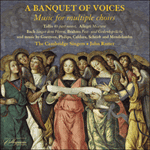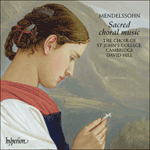
Welcome to Hyperion Records, an independent British classical label devoted to presenting high-quality recordings of music of all styles and from all periods from the twelfth century to the twenty-first.
Hyperion offers both CDs, and downloads in a number of formats. The site is also available in several languages.
Please use the dropdown buttons to set your preferred options, or use the checkbox to accept the defaults.

The relatively brief Heilig, heilig ist Gott, der Herr Zebaoth is an extrovert call to rejoice. The opening, in particular, is unforgettable in its exemplary harmonic control, the overlapping entries combing to produce a glorious suspension at the antepenultimate exhortation of ‘Heilig’. The dotted rhythms which dominate the remainder of the setting help to create a sense of uncontainable forward momentum towards the joyous final cadence.
from notes by Julian Haylock © 2006
Heilig, heilig ist Gott, der Herr Zebaoth, relativement bref, est un appel extraverti à la joie. L’ouverture, surtout, est inoubliable, avec sa maîtrise harmonique exemplaire, avec ses entrées qui se chevauchent et luttent pour produire une glorieuse suspension à l’antépénultième exhortation: «Heilig». Les rythmes pointés qui dominent le reste de la musique contribuent à créer une sensation d’irrépressible élan vers l’avant, vers la joyeuse cadence finale.
extrait des notes rédigées par Julian Haylock © 2006
Français: Hypérion
Das relativ kurze Heilig, heilig ist Gott, der Herr Zebaoth ist ein extrovertierter Aufruf zur Freude. Besonders der Anfang ist aufgrund seiner beispielhaften harmonischen Kontrolle unvergesslich: die sich überschneidenden Einsätze führen zu einem großartigen Vorhalt beim vorvorletzten Ausruf des Wortes „heilig“. Die punktierten Rhythmen, die den Rest der Vertonung beherrschen, helfen, durchweg ein Gefühl uneindämmbarer Vorwärtsbewegung bis zur freudigen letzten Kadenz zu erzeugen.
aus dem Begleittext von Julian Haylock © 2006
Deutsch: Elke Hockings
 A banquet of voices A banquet of voices"Revisiting this 1993 Cambridge Singers recording, I realize I should never have withdrawn it from the Collegium catalogue—and all because of an obscure musicological question in my mind over a Gregorian chant, long since resolved. We assembled a ...» More |
 Mendelssohn: Sacred choral music Mendelssohn: Sacred choral music‘Outgoing, excitingly resonant, spirited singing’ (Gramophone) ‘I doubt that you would find a better performance of Mendelssohn's sacred choral music than this. Finely executed with immaculate phrasing sensitively ...» More |

